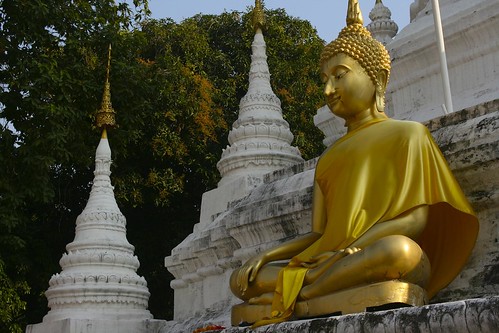What Karma Is
In 1908, in what surely must be one of the most creative public outreach efforts in history, members of Gideon’s International placed Bibles in the rooms of the Superior Hotel in Montana.
In the century that followed the organization has distributed millions of Bibles in 180 countries and 80 languages. Still, I was surprised to find a Gideon Bible in the bedside table of our hotel in Thailand, a country that is 95% Buddhist.
In the drawer, tucked next to the Gideon Bible, I noted another slimmer book: A Constitution for Living – Buddhist Principles for a Fruitful and Harmonious Life.
Curiosity got the better of me and I picked up the book.
There is no firm estimate of the number of practicing Buddhists in the world today – some claim as many as 500 million, others as few as 250 million. (As a point of reference, there are approximately 1.5 billion Christians).
Buddhism is based on teachings attributed to Siddhartha Gautama, who came to be known as “The Buddha” (the Awakened One). Siddhartha lived four hundred years before Jesus in what is today northeastern India.
Buddhists recognize him as an awakened teacher who shared his insights to help people end their suffering by understanding the true nature of reality, thereby eventually achieving enlightenment (i.e., Nirvana).
How one achieves Nirvana is the study of a lifetime, not a blog post. Briefly, though, here are three concepts that caught my attention.
First, there is the concept of the Four Noble Truths:
- To live means to suffer, because the human nature is not perfect and neither is the world we live in.
- The origin of suffering is desire, passion, pursuit of wealth and prestige, striving for fame and popularity, or in short: attachment, craving and clinging.
- Suffering can be ended by attaining dispassion.
- There is a path to the end of suffering through self-improvement, which is described more detailed in the Eightfold Path.
Which leads to the second concept, the Eightfold Path to dispassion and eventually Nirvana:
- Viewing reality as it is, not just as it appears to be.
- Having the right intentions behind thoughts and actions.
- Speaking in a truthful and not hurtful way.
- Acting in a non-harmful way.
- Pursuing a non-harmful livelihood.
- Trying to improve.
- Being aware of the present reality within oneself, without any craving or aversion.
- Practicing correct meditation and concentration.
Finally, there is the concept of Karma: The belief that one’s thoughts and actions have cosmic consequences.
Good thoughts and deeds plant good seeds. And bad thoughts and deeds? Well, you know the saying: Karma is a bitch.






2 comments
I think the US Congress can use the Eightfold Path to dispassion and Nirvana. As for me, the closest I will get to Nirvana today will be on iTunes…but there is always tomorrow!!!
take care over there
I have close friend who was in the peace corps in Nepal. He once wrote an op.ed in the NYT about America’s conspicuous consumption. Later he married a wonderful woman from Nepal. We adore her. She is Buddhist. At peace. But don’t get in her way when she wants to go to the mall.
Can we embedded in our culture disengage and follow that path?
Random sightings on walls.
To be is to do–Satre
To do is to be –Camus
Shoo-be-do-be-do-Sinatra
“Don’t you feel a lot more like you do now then when you first came in here?” –sign at the Texas Chili Parlor in Austin, TX
If a man says something in the forest and a woman isn’t there to hear him–is he still wrong.
Peace out.